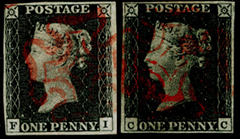 First Issues Collectors Club
of stamps and philatelic material
First Issues Collectors Club
of stamps and philatelic material
Home - Catalog - Categories - Index - Journal - Exhibits - Auctions - Forgeries - Join
 First Issues Collectors Club
of stamps and philatelic material
First Issues Collectors Club
of stamps and philatelic material
Home - Catalog - Categories - Index - Journal - Exhibits - Auctions - Forgeries - Join
| first issues > countries > sochi |
| South Russia | 1d |
† "Taking into account the political background of the Sochi issue, collectors are free to decide whether they should collect these stamps under South Russia or Georgia", CSRP
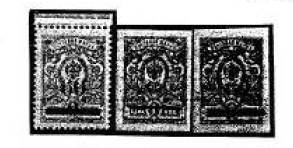 |
||
| Sochi 1-3 | xxx |
| Description | CSRP | Scott ‡ | SG ‡ | Mi | Y&T | |
|---|---|---|---|---|---|---|
| Stamps of Russia surcharged | ||||||
| 60 (kopeks) on 1k orange-yellow perf | 1 | |||||
| 60 (kopeks) on 1k orange-yellow imperf | 2 | |||||
| 60 (kopeks) on 3k carmine-red imperf | 3 | |||||
‡ Not found in Scott or Gibbons
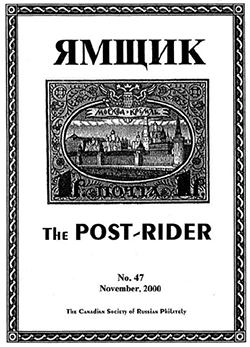 |
The original FICC entry on South Russia cites an article by Alexander Epstein, The Postal History of South Russia 1917 - 1920 : Issues and Rates published in The Canadian Society of Russian Philately, journal, The Postrider, Issue Nr. 47, November 2000. The CSRP is no longer active but their archive has been taken over by ROSSICA and issues of Postrider are available from the University of Floida Digital Collections. Issue 47 is available here and the article covers pages 7 to 53.The portion of the article relating to Sochi is quoted in full below.
The Sochi District
By the end of 1918, the Sochi resort district in a part of the Black Sea Province, including a few villages or
small towns with Sochi and Adler the most significant of them, was actually cut off from the rest of the
world. The railway ended at Tuapse, the surface roads were impassable during the winter period and the
only communications maintained by sea, but there were very few ships calling at Sochi in 1918-1919.
The Sochi district was outside the area of military fighting between the Reds and the Whites, with only the so-called "Greens", consisting of army deserters and other elements who did not want to join the main
fighting parties and were based in the neighbouring mountains, occasionally took over the area. Under
those circumstances, Georgia, which had its own pretensions to this area, occupied the coastal strip from
Adler to Tuapse during July 1918. That led to a worsening of relations between Georgia and the Volunteer
Army Command. The latter ordered a complete mopping-up of the entire Black Sea Provincc up to the
Bzyb River (the border between the Sochi district of the Black Sea Province and the separate Sukhumi
district) and its troops were moved to the district borders. In September, the Volunteer Army recaptured
Tuapse and Lazarevskaya. Only after the intervention of the British Military Mission in the Caucasus did
the Georgian Government agree to abandon Sochi and Adler, while the Volunteer Army forces completely
occupied this area by 10 February 1919.
During the period under consideration, the Sochi district was administered by a Town Committee, in the presence of a detachment of Georgian troops. The Town Committee was formally subordinate to the Government of the Republic of Georgia through the commander of that detachment. The postal service seemed to function over the greater part of this period, although its activities were limited to the territory of the district (postal connections with Georgia, while possible theoretically, at least \vith the neighbouring Abkhazian localities such as Gagry, Gudauty and Sukhumi, hardly existed due to the lack of transport communications mentioned above). Also, it is not known whether other post offices apart from those at Sochi and Adler were functioning at that time. The latter office applied the current postal rates of Georgia, in particular 40 k. for postcards. 60 k. for letters and 60 k. for registration.
To meet these rates under the condition of shortages of postage stamps, at least of those of higher face values, the post ollice at Sochi effected a local issue by surcharging with "60" (k.) in black by a typographic process three different stamps of the Imperial Arms issue.
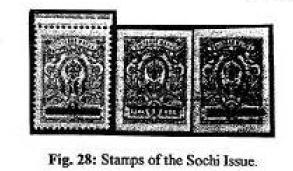 |
Fig. 28 |
Sochi issue. December 1918 (Fig. 28).
1. 60 (k.) / 1 k. orange-yellow, perforated.
2. 60 (k.) / 1k. orange-yellow, imperforate.
3. 60 (k.) / 3 k. carmine-red, imperforate.
The total number of stamps surcharged was 2,500 copies, which is believed to be divided between the
particular types of stamps as follows:
No. 1 - 500 copies (800 according to another source),
No. 2 - 1,500 copies (1,200 according to another source) and
No.3 - 500 copies.
Due to the primitive typographic process of overprinting the stamps, a sheet of 100 is composed of 7 different types of the surcharge (large and small "60", with or wilbout a horizontal bar of different sizes under the "60" (see for example reference [11] P.T. Ashford & R. Taylor. Sochi: the 1918 surcharge - a further look. BJRP 77,24-31, 1994). Also, plate errors "90" and "09" exist.
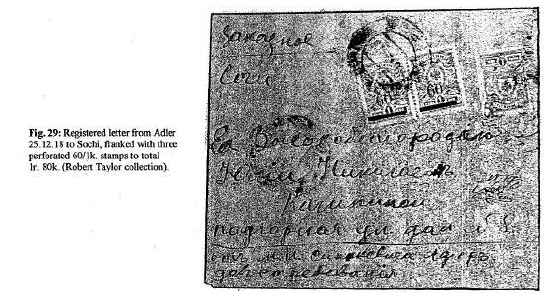 |
Fig. 29 |
It is believed that no more than 4 or 5 genuine covers franked with the Sochi stamps have been preserved, all of them being envelopes of ordinary or registered letters mailed locally at Sochi or between Sochi and Adler (see Fig. 29). Used copies of Nos. 1 to 3 exist on pieces, as well as in blocks of fouf or other multiples, all cancelled (partly c.t.o.) with a serial "b" Sochi postmark. It still remains unknown if other postal establishments in this area (Lazarevskaya, Khosta etc.) were functioning and using Sochi stamps during this period.
It also remains unknown whether the postal service in the Sochi district dealt with other classes of mail and
specifically postcards. No special surcharges were made on stamps for those purposes. For example,
postcards could have been franked with a pair of 20 k. Arms stamps, if such were available at the post
offices. Postcards franked in that way may well exist and remaining still unnoticed by collectors because of
their franking with very common stamps.
† Taking into account the political background of the Sochi issue, collectors are free to decide whether they
should collect these stamps under South Russia or Georgia.
Sources: ScS, SGP10, Post Rider Issue 47.
Images from Post Rider Issue 47.
| FI ref: 479 | Page credit: NB |
| Page created 2 July 2017 | Page updated 04-Jul-2017 |